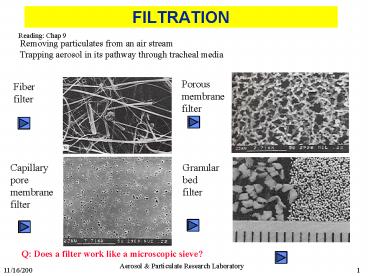FILTRATION - PowerPoint PPT Presentation
1 / 20
Title:
FILTRATION
Description:
Trapping aerosol in its pathway through tracheal media ... Q: Why standard filter test using 0.3 um DOP? Aerosol & Particulate Research Laboratory ... – PowerPoint PPT presentation
Number of Views:284
Avg rating:5.0/5.0
Title: FILTRATION
1
FILTRATION
Reading Chap 9
Removing particulates from an air stream Trapping
aerosol in its pathway through tracheal media
Porous membrane filter
Fiber filter
Capillary pore membrane filter
Granular bed filter
Q Does a filter work like a microscopic sieve?
2
Fibrous Filter
- Cylindrical shape fibers
- Most perpendicular to the direction of air flow
- Fiber size submicron to 100 um
- Material cellulose, glass, plastic
- Porosity 70 to gt 99
- Velocity low 10 cm/s, laminar
Glassfiber filter
TiO2 Nanofiber
3
Porous Membrane Filter
- Irregular path through complex pore structure
- Porosity 50 - 90
- High efficiency high pressure drop
- Material cellulose ester, sintered metals, PVC,
Teflon
Cellulose ester porous membrane filter
Silver porous membrane filter
http//www.2spi.com/catalog/spec_prep/images/silve
r.gif
4
Capillary Pore Membrane Filter
- An array of microscopic cylindrical holes of
uniform diameter - Pores are perpendicular to the surface of the
filter - The straight path results in lower efficiency
compared to other types of filter - The smooth surface is particularly useful for
collecting particles for observation in microscope
Nuclepore capillary pore membrane filter
Anopore inorganic pore membrane filter
http//www.2spi.com/catalog/spec_prep/images/pg82_
1.gif
5
Granular Bed Filter
- A bed of fine granules
- Good for corrosive aerosols and at high
temperature - Good for both air and aerosol
- Materials activated charcoal, glass, quartz,
metal beads - Aerosols are removed by washing, volatilization
or using solvents
6
Single Fiber Efficiency
- E? the fraction of particles approaching a fiber
in the region defined by the projected area of
the fiber that are ultimately collected on the
fiber
Packing density/solidity
Fiber 0.01 ? 0.3 Membrane 0.1 ? 0.5
u0
Q Theoretical max efficiency?
(face velocity)
7
- Total length of fiber in a unit volume
- Number of particles collected when a unit volume
of aerosol passes through an element of a unit
cross section and thickness dh - Filter Efficiency
df fiber diameter
n aerosol concentration A area
Q Impact of df? a ?
8
(No Transcript)
9
Filtration Mechanisms
Valid for 005 lt a lt 0.2 0.1 lt U0 lt 200 cm/s 0.1
lt df lt 50 mm Ref lt 1
- Diffusion (Lee Liu, 1982)
Q Physical meaning?
Q Impact of U0? a ?
http//aerosol.ees.ufl.edu/respiratory/section04.h
tml
Lee, K. W. and Liu, B. Y. H., Aerosol Sci.
Technol., 147-61, 1982
10
- Interception (Krish Stechkina, 1978)
Q Effect of increasing velocity? Increasing R?
Krish, A. A. Stechkina, I. B., The theory of
Aerosol Filtration with Fibrous Filters, in
Fundamentals of Aerosol Science, Ed. Shaw, D.
T., Wiley, 1978.
11
- Impaction (Yeh Liu, 1974)
Q How to have a larger Stk?
Yeh. H. C. and Liu, B. Y. H., J. Aerosol Sci.,
5191-217, 1974
12
- Enhanced collection of diffusing particles due to
interception - Gravitational Settling
- Total Efficiency
Q Any other mechanism?
Q How do these efficiencies change wrt dp?
13
- Single fiber efficiency of different mechanisms
(h 1mm, a 0.05, df 2mm U010 cm/s) Table
9.2
14
Q Implication? Q Why standard filter test
using 0.3 um DOP?
15
- Total collection efficiency as a function of dp
for 2 face velocities (h 1 mm, a 0.05, df 2
mm)
16
- Total collection efficiency as a function of face
velocity for 4 particle sizes (h 1 mm, a
0.05, df 2 mm)
17
Filtration characteristics of a fibrous filter h
1 mm, ? 0.05 and df 2 mm
Important mechanisms included contribute more
than 20 of the total ES.
18
At minimum efficiency (assuming only diffusion
interception)
Q Valid assumption?
m
m
- Pressure Drop
Q Dp for filters having df smaller than 1 mm is
less than predicted. Any reason? Implication?
19
Filter Quality
Q Is an increase in pressure drop bad?
Q Does it matter if particles are solid or
liquid? Q What is pleated filter? Whats its
advantage over a flatpiece filter?
20
Reflection































